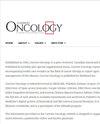揭示新型全球免疫-营养-炎症指数(GINI)对 4 级成人型弥漫性胶质瘤患者生存结果的预测价值
IF 2.8
4区 医学
Q2 ONCOLOGY
引用次数: 0
摘要
研究背景这项研究评估了新开发的全球免疫-营养-炎症指数(GINI)在4级成人型弥漫性胶质瘤患者中的预测和预后效果,并将其与其他已建立的指数(如全身免疫-炎症指数(SII)、全身炎症反应指数(SIRI)和泛免疫-炎症值(PIV))进行了比较。研究方法回顾性队列包括198名被诊断为异柠檬酸脱氢酶(IDH)突变型gr4(4级)星形细胞瘤和IDH-wt(野生型)胶质母细胞瘤(GBM)gr4的患者,这些患者均接受过手术切除、放疗和替莫唑胺治疗。根据 GINI 值将患者分为两组:低 GINI 组(<5815)和高 GINI 组(≥5815)。主要终点是总生存期(OS)。结果显示高 GINI 与年龄大、表现状态差、多灶肿瘤以及较高的 SII、SIRI 和 PIV 值明显相关(P < 0.005)。GINI 与 SII(r = 0.694)、SIRI(r = 0.516)和 PIV(r = 0.657)有很强的相关性(p < 0.001)。与低 GINI 患者相比,高 GINI 患者的 OS(5.0 个月 vs. 17.0 个月)和 PFS(5.0 个月 vs. 13.0 个月)较差。Kaplan-Meier 生存分析显示,低 GINI 患者的 OS 和 PFS 明显延长(p < 0.001)。多变量分析发现,高 GINI 是 PFS 和 OS 的独立负风险因素。结论GINI是IDH突变型gr4星形细胞瘤和IDH-wt GBM gr4临床预后的可靠预测因子,凸显了营养和癌症恶病质的重要影响。与 SII、SIRI 和 PIV 相比,它显示出更高的预后价值。本文章由计算机程序翻译,如有差异,请以英文原文为准。
Unraveling the Predictive Value of the Novel Global Immune-Nutrition-Inflammation Index (GINI) on Survival Outcomes in Patients with Grade 4 Adult-Type Diffuse Gliomas
Background: This investigation evaluated the predictive and prognostic efficacy of the newly developed global immune-nutrition-inflammation index (GINI) in patients with grade 4 adult-type diffuse gliomas, comparing it with other established indices such as the systemic immune-inflammation index (SII), systemic inflammation response index (SIRI), and pan-immune-inflammation value (PIV). Method: A retrospective cohort included 198 patients diagnosed with isocitrate dehydrogenase (IDH)-mutant gr4 (grade 4) astrocytoma and IDH-wt (wilde-type) glioblastoma (GBM) gr4 treated with surgical resection, radiotherapy, and temozolomide. Patients were stratified into two groups based on their GINI values: low GINI (<5815) and high GINI (≥5815). The primary endpoint was overall survival (OS). Results: High GINI was significantly associated with older age, poor performance status, multifocal tumors, and higher SII, SIRI, and PIV values (p < 0.005). The GINI demonstrated strong correlations with SII (r = 0.694), SIRI (r = 0.516), and PIV (r = 0.657) (p < 0.001). Patients with high GINI exhibited poorer OS (5.0 vs. 17.0 months) and PFS (5.0 vs. 13.0 months) in comparison to those with low GINI. Kaplan–Meier survival analysis revealed significantly prolonged OS and PFS among patients with low GINI (p < 0.001). Multivariate analysis identified high GINI as an independent negative risk factor for both PFS and OS. Conclusions: GINI is a robust predictor of clinical outcomes in IDH-mutant gr4 astrocytoma and IDH-wt GBM gr4, highlighting the crucial impact of nutrition and cancer cachexia. It shows superior prognostic value relative to the SII, SIRI, and PIV.
求助全文
通过发布文献求助,成功后即可免费获取论文全文。
去求助
来源期刊

Current oncology
ONCOLOGY-
CiteScore
3.30
自引率
7.70%
发文量
664
审稿时长
1 months
期刊介绍:
Current Oncology is a peer-reviewed, Canadian-based and internationally respected journal. Current Oncology represents a multidisciplinary medium encompassing health care workers in the field of cancer therapy in Canada to report upon and to review progress in the management of this disease.
We encourage submissions from all fields of cancer medicine, including radiation oncology, surgical oncology, medical oncology, pediatric oncology, pathology, and cancer rehabilitation and survivorship. Articles published in the journal typically contain information that is relevant directly to clinical oncology practice, and have clear potential for application to the current or future practice of cancer medicine.
 求助内容:
求助内容: 应助结果提醒方式:
应助结果提醒方式:


